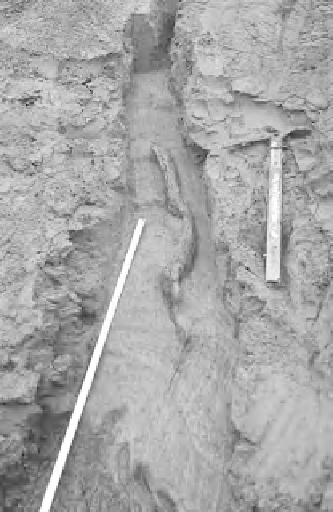Geology Reference
In-Depth Information
(B)
(A)
Figure 7.16.
Syngenetic ice wedges: (A) Large (relict) syngenetic ice wedge in loessic materials,
Fairbanks, Alaska. (B) Small (relict) syngenetic ice wedge (vein) in outwash sands, Sachs River
lowlands, Banks Island, Canada (see French et al., 1982).
1966; Gasanov, 1978; Vasil'chuk and Vasil'chuk, 1997). These high-ice-content sediments
are described as “ice-complex” or “Yedoma” in the Russian literature (Romanovskii et
al., 2000). Large inactive (Pleistocene) syngenetic ice wedges also occur in the muck
deposits of central Alaska (Figure 7.16A; also see Chapter 11). A characteristic of these
wedges, apart from their size, is that their internal near-vertical foliations are truncated
along the sides of the wedges.
In most other permafrost areas, smaller syngenetic wedges and veins are more common
(Figure 7.16B). Certainly, most Pleistocene pseudomorphs of syngenetic wedges that can
be observed today in mid-latitude are also small (French and Gozdzik, 1988; see also
Chapter 12). It appears that the growth of large syngenetic wedges requires exceptionally
long periods of uninterrupted surface-sediment accretion under cold-climate conditions.
Only depositional surfaces of either alluvial or wind origin, located in areas that have
experienced cold non-glacial climatic conditions throughout much of the Pleistocene, are
capable of fulfi lling these requirements. Vasil'chuk and Vasil'chuk (1997) use radiocarbon
dating and oxygen-isotope determinations to show that many of the large syngenetic ice
wedges in Northern Siberia have grown vertically at rates varying between 1.0 m and 2.7 m
per 1000 years throughout the Late-Pleistocene.
7.5.3. Anti-Syngenetic Wedges
Anti-syngenetic wedges form on receding surfaces that are experiencing net surface
removal (i.e. erosion) (Figure 7.14C). If thermal-contraction cracking and ice-vein forma-


